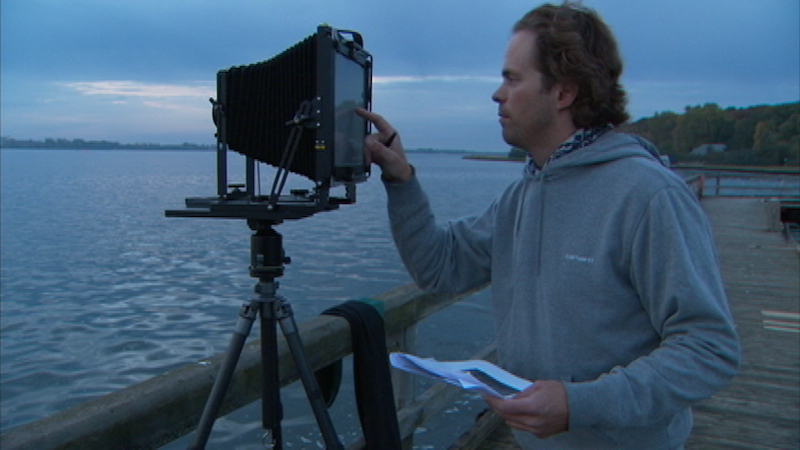
Florian Maier-Aichen takes photographs in Stralsund, Germany, 2008. Production still from the Art in the Twenty-First Century Season 5 episode, Fantasy, 2009. © Art21, Inc. 2009.
In a new previously unpublished interview from 2008 Florian Maier-Aichen discusses his beginnings as an artist, the evolution of his hybrid practice, and his respect for nineteenth-century landscape photographers. Here’s an excerpt:
Art21: What’s the earliest work you can remember that marked the point when you stopped being a student and felt like, “Okay, I really have something”? Is there a work that is the quintessential beginning for you?
Florian Maier-Aichen: The quintessential, “real” beginning for me was when I came to UCLA or when I came to California. I didn’t come for its scenic beauty; I came for the artists who were teaching at UCLA. The art they were making was exactly the art that I liked, and it was a great bonus that they were also actually teaching. It seemed uncommon for me to see those important artists do their day jobs and teach as well. One of the reasons why I thought Los Angeles would be interesting, in terms of photography, was that while German photography was actually kind of starting to repeat itself, there were people working in Los Angeles (like James Welling or Christopher Williams) who used the medium in a more thoughtful way. They investigated more—and dug deeper down into the medium—rather than just creating pictures. The good thing about UCLA was that I usually had one-on-one discussions with my teachers. Studying with John Baldessari meant that we would hang out in my studio (by the time I was working with him, I was working on a sculpture) and discuss the work on a very non-theoretical level, in a hands-on approach—not even throwing ideas off of each other, and maybe not even talking about art, but just having everyday plain conversation. What I learned was that sometimes you can do things wrong and do things the way you’re not supposed to do them. Baldessari was breaking every rule that there was, so it was a huge encouragement for me to question things or standards a little more. A good way to sum it up would be to say that it was okay to just “go wrong.”
Art21: You’re a photographer yet you do so much handwork—you’re constantly drawing.
Maier-Aichen: You probably would dismiss a term like painter-photographer or draftsman-photographer because it’s almost like a hybrid, which people never like. You want to be either in this category or that. But what I like is that I turn the finished photograph almost back into a scribble. Usually a photograph is very finished, precise, and rigorous. It’s an end product. But I like to use the end product and turn it into an unfinished state again. Most people think photography and painting should be strictly separate, even though photography has always mimicked painting because of a kind of inferiority complex (it wasn’t considered artistic enough). The first photographers tried to use painterly devices until straight photography came into fashion and all the modern photographers got rid of the painterly baggage. But I think, today, that photography has become so technical that people have tried to investigate the medium again by researching process or photography’s historical importance. I don’t want to be a dogmatist, so I think that it’s fine to combine photography and drawing, or alter photographs and bring in fictional elements, or just not be satisfied with photography as a super-realistic medium.
Continue reading “Florian Maier-Aichen: Built-in Mistakes” at Art21.org.